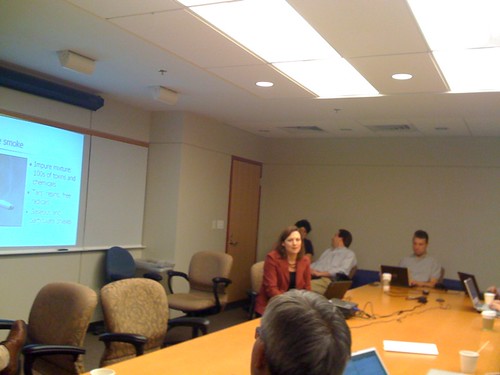Elizabeth Karlsson discussed multiple epidemiological approaches to identifying patients at risk for rheumatoid arthritis.


Elizabeth Karlsson discussed multiple epidemiological approaches to identifying patients at risk for rheumatoid arthritis.


Perlis et al.,
Reviewed pharmacovigilance trends results based on analysis of PHS data.
Nicely done and very informative.
http://www.recomdata.com/www/resources/i2b2_Webinar.wmv
Shawn Murphy led a discussion of the roadmap over the next year of i2b2.

2b2 Roadmap for 2009-2010
Release 1.4 = “Enterprise Ready i2b2”
Release Candidate targeted for September 2009
This release allows the entire set of patients from the enterprise to be exposed to the research community of the hospital while preserving patient privacy, providing the way for basic queries to funnel down to a set of patients interesting to the investigator. The chosen set of patients is matched to controls from the enterprise database and a project-specific mini-database is created. Major software enhancements of release 1.4 compared to release 1.3 include a hardening of the project management cell with a new, full featured client for managing enterprise users, a plug-in architecture for the data repository cell that allows complex server-side workflows, and streamlined project mini-database creation with processes to build sets of matched control patients for a given set of patients of interest.
Release 1.5 = “NLP Workflow Enabled i2b2”
Release candidate targeted for February 2010
This release allows the text notes that are contained in a project-specific mini-database, such as clinic notes of a patient or radiology reports, to be processed in a high throughput manner with natural language processing (NLP). Any NLP tool can fit into this workflow, because the i2b2 workbench serves as a means to flow notes to the workstation of the NLP expert, and once the expert has transformed the text into coded data, re-import the coded data back into the i2b2 hive. The i2b2 workbench will also provide a tool for basic natural language processing to be performed using a Support Vector Machine for people who have no experience with NLP. Major software enhancements of release 1.5 compared to release 1.4 include a hardening of the data import process, a coupling of ontology management with data import processing, and a tool for non-expert NLP users.
Release 2.0 = “Open repository i2b2”
Release targeted for July 2010
This version represents the beginning of an open repository management of i2b2 software. An open Concurrent Versions System (CVS) will allow the i2b2 community to submit changes to the software that will be considered for all new releases.
We recently received news from our informatics colleagues in the German medical research organization (TMF) regarding impressive strides they have made in adopting and adapting the i2b2 codebase. Much of this work has been done under the supervision of Hans-Ulrich Prokosch with his amazingly productive colleague Sebastian Mate. I paraphrase here a recent missive:
First, Sebastian simplified the installation process such that, based on his installation script, they can now set up a new i2b2-installation in less than half an hour. Further, he has already built up a comprehensive Erlangen specific ontologies (urology cancer data items: ICD-10-GM, ICD-O, ICPM, TNM-Codes, Grading, Study Codes, Patient Scores, patient age groups, gender etc).
They have also imported more than 800.000 patient records from their hospital data warehouse, mainly with demographic data, and ICD-codes, procedure codes, gender and age and a second smaller subset with patients from their newly established urology cancer documentation application which is part of their hospital information system.
In their evaluation project for TMF, Sebastian has analyzed the TMF pseudonymisation module and established it as a first preprocessing step before loading data records into the i2b2 hive. All their data within i2b2 are now fully pseudonymized.
Turns out that there are 11,000 distinct laboratory types at Partners Healthcare System alone. The ontological mapping challenge is non-trivial but fortunately can be made scaleable by having every source system provide a mapping into standard such as LOINC.